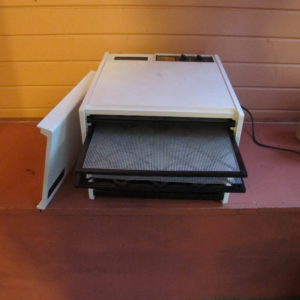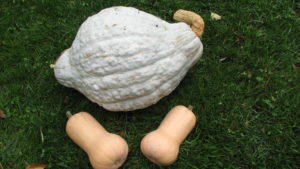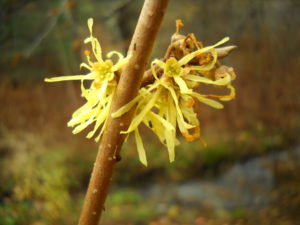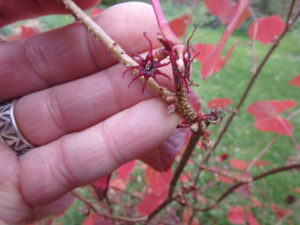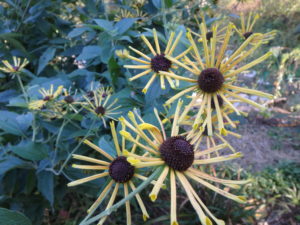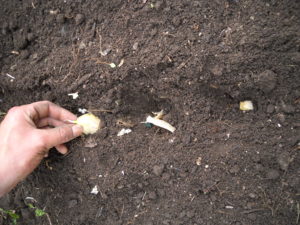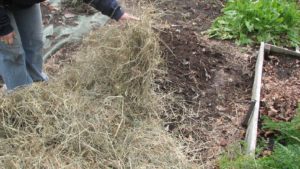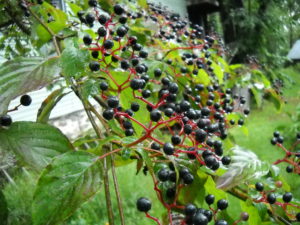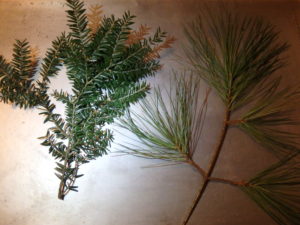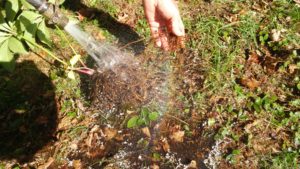How to Eat From Your Garden All Year
This was a good gardening year. Adequate rain, adequate sun. I know that I will have food from the vegetable garden that will allow me to eat something from it every day all year. Eating something every day from my garden is a bit of an obsession, but not all that hard to do. I am putting my root crops away for the winter now, and drying herbs.
My best crop this year was potatoes. In a 30-inch wide (double) row that was nearly 50 feet long I harvested about 125 pounds of potatoes including 5 different varieties. I had no potato beetles even though I used no pesticides, not even the organic Bt bacterial spray. My tip for doing so? Plant late. By mid-June potato beetles have started eating something, somewhere else. Maybe they were munching my neighbors’ potatoes, I don’t know.
When researching a book project in 2002 I drove around the country visiting farms and talking to farmers. In Idaho I worked for 3 weeks as a farm hand on an organic farm that grew potatoes, among other things.
I learned that potatoes need to be stored in a cool environment with high humidity. Commercially that meant storing them right at 50 degrees. At cooler temperatures some of the starches are converted to sugars. That would mean that French fries – America’s favorite potato product – would tend to darken up too much. I don’t make fries, and store my potatoes in a cold basement where they stay between 33 and 50 degrees. They’re very sweet.
Before I store my potatoes I harden them off outside for a few days. I place them on my north-facing deck where they get a good breeze, but not too much sun. I roll them over once a day so that all sides face up for a while.
If you don’t have a cold basement, get a spare fridge. These are often offered for sale used at $100 or less – and over the years I have gotten a couple free. They will keep root crops cool and keep mice from nibbling the harvest. If you keep it in the garage it will never run all winter, though you may need to add some heat inside it in January. A seed-starting heat mat will provide low heat for just a few pennies a week. Keep a thermometer inside it to monitor the temperature.
What else will store well in a fridge? Beets, carrots, rutabagas, kohlrabi and celeriac. Leeks should store well, but don’t. Those I clean, cut up, pack in zipper bags and freeze. Carrots will store well in the ground, but are targets for mice, so I pull them now.
Dried foods last all year, too. I dry tomatoes, herbs, apples, pears, berries and hot peppers. Cherry tomatoes, cut in half, are easy to dry and add great flavor to soups, stews and stir fries. Hot peppers I grind in the coffee grinder so that I can add just a little pepper powder to spice up a dish gently.
Any type of dehydrator will work fine, but the two I like best are the Excalibur and the NESCO American Harvester. The Excalibur is more efficient, but also more expensive to buy.
A cool dry location is good for storing garlic, onions and winter squash. Winter squash like Waltham butternuts and blue Hubbards will store until next summer under the right conditions. A cold spare bedroom is a good spot – 50 degrees is great. Some kinds of onions store better than others. Yellow onions store well, but start to sprout by spring. Then I use my frozen leeks to substitute for onions in cooked dishes.
Freezing garden produce is good, but a bit time consuming. The easiest vegetables to freeze are tomatoes because they’re so easy to freeze. I just put clean tomatoes in a zipper bag and freeze whole, removing them to use in soups and stews like canned tomatoes. And running hot water over a frozen tomatoes will separate the skin from the flesh in just a moment.
Most vegetables need to be briefly boiled before freezing – a minute or less. That is called blanching. But tomatoes, leeks, berries and peppers do not require blanching. Some gardeners blanch kale, while others do not. Blanching kills aging enzymes in food, so if you are going to eat frozen vegetables within 3 months it probably is not needed. But if you want to eat kale, beans, broccoli or summer squash 6 months from when you picked it, blanching is recommended.
One last word on freezing. I recently read a paper from University of California at Davis that explained that I could freeze garlic. Just separate the cloves, put in a freezer bag and freeze. I’ve never done that, but I will try that this year as garlic tends to dry out or sprout after a few months. I have also dehydrated garlic and ground it into a powder.
However you store your food, having something from the garden to eat during a February blizzard will bring a smile to your face- or at least it does from me.
Read Henry’s blog posts at https://dailyuv.com/
Life After Frost: Gardening Is Not Over
Frost was late this year. It was nearly mid-October before we had a hard frost, one that murdered the zinnias and blackened the basil. For me, hard frost is a day to mourn a little, to spend a few moments missing the summer that passed, for the tomatoes that brought me such great pleasure and the flowers that graced my table.
But autumn is grand, too. I still have plenty of garden veggies to harvest and process, and those fall days full of sun and a few monarchs are full of surprises and delights.
I’m always delighted by plants that bloom now –especially woody plants. I have two witch hazels (Hamamelis virginiana) that bloom subtly each fall. The blossoms are not obvious because they are small, yellow, and their leaves are yellow (and green) and have not yet fallen. But those curly blossoms will persist even after the leaves have dropped. Witch hazel is a native tree that lives in shade or part shade. It’s a small tree or a shrub, depending on the variety. It blooms either now, or in very early spring.
Another interesting shrub in bloom now is disanthus (Disanthus cercidifolius). Although most books describe the flowers as “insignificant”, I disagree. They are small – just half in inch across, and close to the stem – but they are in pairs, back to back, each like a small purple starfish. I‘ve had my disanthus for 4 years, and this is the first time it has bloomed, or at least the first time I have seen it bloom. So I yelped with excitement when I first saw the blossoms.
The best thing about disanthus is the leaf color. The leaves are deep red and purple, and have been so for many weeks. The color is better than that of the now prohibited invasive, burning bush (Euonymus alatus). But unlike burning bush, disanthus doesn’t litter the countryside with babies like a stray, unspayed dog. It stays in one place, and grows slowly to a 6 to 10 foot height and width.
In the flower garden my fall asters are about done, but I still have one Rudbekia or black-eyed Susan looking great. It is Rudbeckia subtomentosa, a variety called ‘Henry Eiler’. It’s taller than I am. Its petals are very delicate and are spaced apart in an airy fashion. The stems of this plant are quite thick, but not thick enough to stand up to fall winds without staking.
Grasses are nice now, too. They generally bloom in fall, producing subtle green flowers that most people don’t recognize as flowers. My favorite grass is a Chinese feather grass (Miscanthus sinensis), a variety called ‘Morning Light’. The leaves have a central white stripe and each stem stands up 4 to 6 feet, or even more. This grass will look good all winter waving above the snow.
Each stem of feather grass has 20 or so thin strands of flowers that will produce seeds. This plant does not reproduce from seed, however. The clump gets bigger each year, and can be divided to create more plants. I’ve read that the time to divide it is in the spring, not now.
The milkweed plants I started from seed this year stayed small and did not flower. But I will harvest some seeds elsewhere and plant some more. The seeds need a cold period before they will germinate, so planting outside now makes sense. Last spring I planted seeds in flats indoors, then put them in the fridge for 6 weeks before they would grow. The red milkweed I planted the year before did great this year, blooming and attracting pollinators. I will plant some of their seeds when I see the pods are ripe and ready to burst open.
I’ve cut down some of my perennials, and pretty much all are ready for the knife or shears. I’ll leave things with stiff stems and interesting seed pods for winter viewing and as food for the birds. But the more I can do now, the better. One landscaper told me she figured that every hour of fall clean up reduces spring work by three hours.
One of my last tasks each year is to run over the lawn with my lawnmower, chopping leaves into perfect mulch. I rake it onto a tarp and pull the tarp to my vegetable garden where I spread the leaves over the by-then weeded beds. It keeps weed seeds from germinating in the spring, and adds organic matter to the soil as it breaks down and is eaten by earthworms.
My gardening friend and fellow garden-book writer Sydney Eddison of Connecticut always saves her chopped fall leaves in contractor bags and uses them in the spring on her flowers. I have filled up 6 huge plastic bags with grass clippings and leaves another friend gave me, and have stored them in the barn for use in the spring. Sydney Eddison has the best soil I’ve ever seen after mulching with chopped leaves for 40 years or so.
Don’t forget to plant your spring bulbs now, too. You can plant into November, but it will be cold by then, so get going!
Read Henry’s blog at https://dailyuv.com/
Planting Garlic
Growing garlic involves less work than anything else I grow. There really are only 3 steps: plant it, mulch it, and harvest it. It’s also the least expensive, once you have an established bed of garlic. I will plant this year’s crop from last year’s crop, and that one I planted from the crop of the year before. You really only have to buy garlic once – so long as you save some each year for planting.
There are basically just two kinds of garlic: soft neck garlic, which is what you probably get at your grocery store, and the stuff we grow here in the Northeast called hard neck garlic. Most soft neck garlic comes from California and keeps nearly forever. Hardneck garlic has a stiff stem in the middle of each bulb, and has a much more complex flavor (in my opinion). It will keep in a cool place until spring, but not much longer. Then it either sprouts or dries up.
October is the time to plant garlic. If you don’t have any seed garlic, you might be able to get some at your farmers market. Don’t plant grocery store garlic, even if you can find hard neck garlic, because it is often treated so that it will not sprout. By now most catalog-sellers of garlic have sold out.
Take a bulb (or head) of garlic and separate it into the cloves that surround the hard “neck” or flower scape. Depending on the variety of garlic, you might have just five cloves, or as many as a dozen. I like big cloves, as they are easier to peel and use. So each year I select for big cloves and plant them. Over the years my crop has produced bigger bulbs and bigger cloves.
Garlic needs full sun (defined as 6 hours of sun) and rich soil. I always add compost to my garlic bed and some organic bagged fertilizer. I rake soil from the walkways into a raised bed that is perhaps 30 inches wide and six inches higher than my walkways. Ideally, by adding compost, your soil will be rich and fluffy.
To plant, I draw furrows about 8 inches apart with my CobraHead weeder, a single-tined tool that is curved like a bent finger. I loosen the soil about 6 inches deep withit, than push cloves into the soil so that they are 3 inches apart and about 3 inches deep. Always plant them with the pointy end up. Afterwards I pat the soil down with my hands to firm the soil.
The last step is to mulch your garlic. I use mulch hay or straw and put almost a foot of fluffy material over the bed. Fall rains and winter snows will cause the hay to settle – I end up with about 4 to 6 inches of material in the spring.
The mulch keeps the soil from freezing until January, allowing roots to get well established before the garlic cloves go dormant. It also prevents most weeds from germinating and growing next year, though I weed the bed before planting. Garlic is tough stuff and will push right through my layer of mulch, though most weeds do not.
Depending on the weather and when you plant, your garlic may send up green stalks this fall. Don’t fret if it does. Those sprouts will die back in winter, but the garlic will send up new ones in the spring.
In early summer the scape, or flower stalk, will perform for you, “dancing” to create loops, swoops and circles of green. I use these in flower arrangements. Each scape produces a flower on top of the scape that will, if left, produce seeds. Those seeds are not useful for the average gardener, as they will not produce edible garlic for 2 years. But the stems and flowers are great for early summer stir fries. Garlic scapes are a taste treat.
Some believe that cutting off the scapes early on will produce bigger cloves of garlic, but I have never been able to tell if that is true or not, though it makes sense. Producing flowers and seeds uses energy that might otherwise go to producing bigger bulbs.
Next July the garlic you planted this year will be ready to harvest. Each bulb grows about 7 long pointy leaves that also surround the cloves and protects them. When 3 or 4 leaves have turned brown and started to dry up, it’s time to harvest. If you wait too long, all the leaves will have dried up and the garlic will not store as well – it will dry out too soon.
I’ve been told that after harvesting that garlic should be cured in a cool shady place for a week or two before you cut off the tops. Why? Because nutrients in the leaves – some of which are allegedly good for preventing cancer – will migrate to the bulbs and be absorbed.
You can store garlic best in a cool, dry place. Ideally 50 degrees with moderate humidity. I recently read an article produced at the University of California at Davis that you can freeze garlic instead of storing it at room temperature. Separate the cloves, but don’t peel them. You can freeze them in a zipper bag or jar for a year or more. I shall try that. Don’t store garlic at room temperature in oil, as it can produce deadly botulism.
Garlic may or may not repel vampires and viruses. I do know it makes food taste better, and is full of vitamins and minerals. So I grow it, and you should, too.
You can reach Henry at henry.homeyer@comcast.net. Read his blogs at https://dailyuv.com/gardeningguy.
Planting For the Birds
I’ve never calculated how much I spend each year on bird seed, but it’s considerable. I know people some spend a lot more, who think nothing of buying big bags of 2 or 3 kinds of specialized seeds for the birds every few weeks, and who maintain half a dozen feeders much of the year.
Does Mother Nature buy bags of booty for birds? No. We can reduce our expenditures and help the birds through judicious management of our wild spaces and our gardens. Now is a good time to plant a few things for the birds.
To support birds, it’s important to provide them with food all year, nesting places, and safe places out of the reach of cats, foxes and hawks. Agreed, it is easier to feed black oil sunflower seeds to provide food in winter than to plant trees, but there are trees and shrubs that do provide fall and winter food.
Shrubs are great for summer and fall treats. Pagoda dogwood (Cornus alternifolia) provides berries that are eaten voraciously in mid-August, but are long gone now. Same for blueberries, which, alas, are enjoyed by the birds as much as they are by us.
Three shrubs that produce fall berries are silky dogwood (Cornus amomum), red osier dogwood (Cornus sericea) and gray dogwood (Cornus racemosa). The first two grow wild in wet areas in part shade to full sun. Gray dogwood appears at the edges of dry forests. All produce berries enjoyed by birds. I went out in early October and found just a few berries left on silky dogwood growing wild near my stream. All have berries from August to October.
For winter food, nuts and cones are the best source of bird food. It’s true that most birds cannot break open a walnut, chestnut or acorn – though I have seen crows feeding on walnuts broken open on the road. But as the winter progresses, nuts soften and the interiors become available to birds. Squirrels are messy eaters, and often leave parts of nuts scattered on the ground and available to birds, too.
Two of the most popular trees with birds are the white pine and Canadian hemlock. Not only do they provide food – seeds from their cones – they provide shelter and nesting places. The eastern white pine is used by more than 40 species of birds, and Canadian hemlock is used by more than 25 species.
If you are interested in learning more about trees and shrubs used by birds, I highly recommend a book by Richard M. DeGraaf, Trees, Shrubs and Vines for Attracting Birds (University Press of New England, 2nd edition, paperback at $24.95). This book lists, for each common species of woody plant, the birds that use it, and how they use it.
Is this a good time to plant trees and shrubs? Yes. Actually there are two schools of thought about this. Scientists have determined that trees and shrubs extend their roots in the fall, even after leaf drop. So many plantsmen, myself included, vote for fall planting. Not only are roots going to grow, the climate is usually cooler and wetter, so the chances of drying out are smaller.
The other school of thought maintains that planting in spring is better. They say that so long as you are attentive to your plants, and keep them watered, they have more time to get settled in before the stress of winter. I’m a careful gardener, but a busy person, and I know how easy it is to forget about watering for a week or two – which in august can be deadly. So I say plant now – or in September, but not after early November.
I recently went to a gardening workshop where one of the presenters advocated removing much of the soil from perennials purchased in pots before planting. The idea is that plants grown in pots get their roots all snarled up over time, and have roots circling the plants. I have always teased out plant roots with a finger or a tool, but have never used her suggestion – a stream of water.
So recently I tried using the hose to loosen plant roots, and, much to my surprise, it worked very well. I thought I’d be holding a handful of mud and a disintegrating root ball, but it worked fine. So next time I plant a tree or shrub, I shall try using a sharp stream of water to wash away some of the soil and to allow me to tease out the roots more easily – without breaking them.
But back to the birds. Here is a list of plants that DeGraaf’s book list as helping 20 or more species of birds: balsam fir, sugar maple, serviceberry (Amelanchier spp.), birches, flowering dogwood (Cornus florida), beech, Eastern red cedar, apples and crabapples, red mulberry, black tupelo, spruces, pitch pine, cherries of all kinds, oaks and American elm. That list includes some Zone 5 and 6 trees, so not all are appropriate everywhere.
Of the shrubs, here are some of the best: dogwoods of all kinds, hawthorn, huckleberry, bayberry, staghorn sumac, roses, brambles of all sorts, elders and blueberries. Common grapevine is also highly useful for birds.
It’s true most of us do not have garden space for more big trees, but there is always space for a few more shrubs along the edges of our space. So get out your shovel and get to work!
You may reach Henry by e-mail at henry.homeyer@comcast.net. Read Henry’s regular blogs at https://dailyuv.com/




